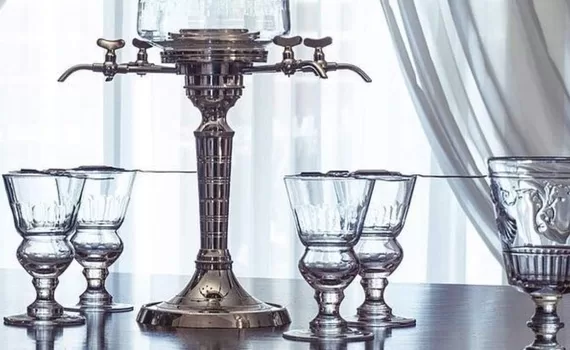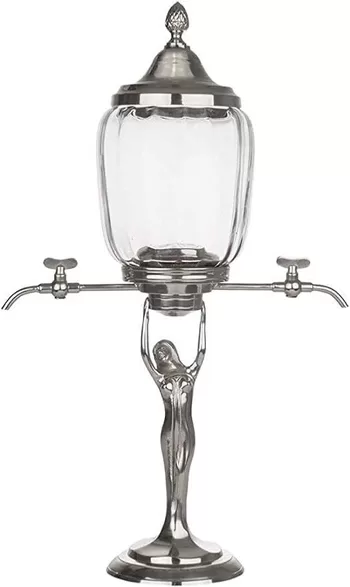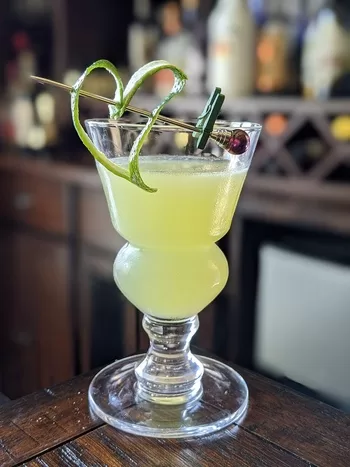Absinthe, often referred to as “The Green Fairy,” is one of the most enigmatic and storied spirits in the world. With a history steeped in mystique, controversy, and allure, absinthe has captivated artists, writers, and drinkers for centuries. This blog will delve into the origins, production, cultural impact, and modern resurgence of this fascinating drink.
Our Guide to all things Absinthe continue after this advertisement:
Origins of Absinthe
Absinthe originated in the late 18th century in Switzerland, specifically in the Val-de-Travers region. Initially created by Dr. Pierre Ordinaire, a French doctor living in Switzerland, absinthe was originally intended as a medicinal elixir. The recipe, which included grand wormwood (Artemisia absinthium), anise, and fennel, was eventually sold to Henri-Louis Pernod, who began commercial production in 1797. The drink quickly gained popularity across Europe, particularly in France.
The Absinthe Boom
By the mid-19th century, absinthe had become immensely popular in France, especially among artists, writers, and bohemians. The drink was associated with creativity and inspiration, with notable figures such as Vincent van Gogh, Oscar Wilde, and Ernest Hemingway among its enthusiasts.
Absinthe was commonly consumed in cafes and bars, often referred to as “The Green Hour” due to its typical consumption in the late afternoon.
Production and Ingredients
Absinthe is a highly aromatic spirit distilled from various herbs and botanicals, with three primary ingredients: grand wormwood, anise, and fennel. The production process involves several steps to create its distinctive flavor and appearance.
The first step is maceration, where the herbs are soaked in high-proof alcohol to extract their essential oils and flavors. This macerated mixture is then distilled, capturing the aromatic compounds while leaving behind impurities.
To achieve its characteristic green color and enhance its flavor, the clear distillate is often infused with additional herbs such as petite wormwood, hyssop, and melissa. Finally, the absinthe is diluted to the desired strength, typically between 45-74% ABV (alcohol by volume), and then bottled.
The Green Fairy Ritual
One of the most captivating aspects of absinthe is its traditional preparation ritual, which adds to its mystique. The ritual begins by pouring a small amount of absinthe into a glass. Next, a specially designed absinthe spoon, often slotted or perforated, is placed over the glass.
A sugar cube is then placed on the spoon. Ice-cold water is slowly dripped over the sugar cube, dissolving it and diluting the absinthe. This process, known as “louching,” causes the drink to turn a milky, opalescent green as the essential oils emulsify with the water.
Finally, the mixture is stirred, and the absinthe is ready to be savoured.
Accessories for Absinthe: Enhancing the Ritual
Absinthe is not just a drink; it’s an experience steeped in ritual and tradition. The preparation and consumption of absinthe involve a variety of specialized accessories that enhance its mystique and enjoyment. Here’s a closer look at the key accessories used in the absinthe ritual:
Absinthe Glasses
Pontarlier Glasses
Pontarlier glasses are the most iconic absinthe glasses, named after the French town of Pontarlier, known for its absinthe production.
These glasses feature a reservoir at the bottom to measure the correct amount of absinthe before dilution with water.
The elegant design of Pontarlier glasses adds to the visual appeal of the absinthe ritual.
Brouille Glasses
Brouille glasses come with a built-in reservoir or dripper on top of the glass. This allows for the slow dripping of water over the sugar cube, an essential part of the absinthe preparation ritual. The integrated design makes the process more seamless and adds a touch of sophistication.
Absinthe Spoons
Slotted Spoons
Absinthe spoons are specially designed slotted or perforated utensils used to hold a sugar cube over the glass. The spoon rests on the rim of the glass, allowing the sugar cube to dissolve slowly as water drips over it.
These spoons are often intricately decorated, with ornate designs that add to the aesthetic experience.
Perforated Spoons
Perforated spoons, similar to slotted spoons, feature various patterns of holes and slots. The design allows for a more even distribution of water as it passes through the sugar cube.
Perforated spoons come in many artistic designs, making them a collector’s item for absinthe enthusiasts.
Absinthe Fountains
Traditional Fountains
Absinthe fountains are elegant devices used to dispense ice-cold water in a slow, controlled manner. These fountains typically have multiple spouts, allowing several glasses to be prepared simultaneously. The slow drip of water over the sugar cube ensures a perfect louche, the milky transformation of absinthe when mixed with water.
Drippers and Balanciers
Drippers, also known as balanciers, are simpler devices used to control the flow of water onto the sugar cube. They often feature a see-saw mechanism that tips the balance as water flows, ensuring a steady drip. Drippers are a practical and decorative alternative to larger fountains.
Absinthe Carafes
Water Carafes
Water carafes are essential for serving the cold water used in the absinthe ritual. These carafes often feature a long, narrow neck for precise pouring. Some carafes are designed to fit over the absinthe spoon, allowing for a slow and controlled pour.
Ice Carafes
Ice carafes, or ice-water carafes, are used to keep the water at an optimal cold temperature. These carafes may have a compartment for ice, ensuring that the water remains chilled throughout the preparation process.
Sugar Cubes and Tongs
Sugar Cubes
Sugar cubes are a crucial component of the traditional absinthe preparation ritual. The sugar helps to balance the bitterness of the absinthe and enhances its complex flavors. Absinthe-specific sugar cubes are often slightly larger to fit the absinthe spoon perfectly.
Sugar Tongs
Sugar tongs are used to place the sugar cube onto the absinthe spoon without contaminating it with hands. These tongs are often ornate and match the style of other absinthe accessories, adding to the overall elegance of the ritual.
Absinthe Brouilleur
Brouilleurs
A brouilleur is a small device placed on top of the absinthe glass, designed to control the flow of water onto the sugar cube. Brouilleurs come in various styles, including simple drip devices and more elaborate see-saw mechanisms. They ensure a slow and steady flow of water, enhancing the louche effect.
The accessories used in the absinthe ritual are more than just tools; they are integral to the experience, adding to the drink’s mystique and tradition. From the elegant Pontarlier glasses to the intricate slotted spoons and the majestic absinthe fountains, each accessory plays a vital role in preparing and enjoying absinthe. Whether you are a seasoned absinthe enthusiast or a curious newcomer, using these accessories can elevate your absinthe experience, allowing you to fully appreciate the allure of The Green Fairy.
The Ban and Resurgence
Absinthe’s popularity in the late 19th and early 20th centuries led to increasing scrutiny and controversy. The drink was blamed for a range of social problems, from addiction to criminal behavior, and was even linked to hallucinations and madness due to the presence of thujone, a compound found in wormwood. These fears culminated in absinthe being banned in many countries, including the United States and most of Europe, by the early 20th century.
However, modern research has debunked many of the myths surrounding absinthe, revealing that the levels of thujone in the drink are not harmful. As a result, absinthe has experienced a resurgence since the 1990s, with bans being lifted and production resuming under new regulations.
Modern Absinthe Culture
Today, absinthe is enjoying a revival, with a growing number of artisanal producers and enthusiasts rediscovering the drink’s rich history and complex flavors. Absinthe bars and lounges have emerged in cities around the world, offering a variety of traditional and innovative absinthe cocktails.
Absinthe Cocktails
While the traditional preparation remains popular, mixologists have also embraced absinthe as a versatile ingredient in cocktails. Some classic absinthe cocktails include the Sazerac, a New Orleans classic made with rye whiskey, a dash of absinthe, Peychaud’s bitters, and a sugar cube. Another popular cocktail is Death in the Afternoon, created by Ernest Hemingway, which combines absinthe with champagne for a refreshing, bubbly experience. The Corpse Reviver No. 2 is a pre-Prohibition era cocktail featuring gin, Cointreau, Lillet Blanc, lemon juice, and a dash of absinthe.
Absinthe, with its storied past and captivating allure, continues to fascinate drinkers around the world. Whether enjoyed in its traditional form or as part of a modern cocktail, absinthe offers a unique and enchanting experience. As the myths and misconceptions surrounding the Green Fairy fade, a new generation of enthusiasts is discovering the magic and mystery of this legendary spirit. So next time you’re in the mood for something extraordinary, pour yourself a glass of absinthe and let the Green Fairy guide you on a journey through history and imagination. Cheers!
°°°°°°°°°°°°°°°°°
Buy Cocktail accessories on Amazon here


Related stories
Absinthiana: Collectible Absinthe Spoons and Accessories
Are Old & Vintage Corkscrews Collectible?
Effervescent Charm of Champagne Cocktails, 10 Best Recipes
The story of the NSW Rum Corp, Holey Dollar and Dump coins
Collecting 1937 & 1938 Australian Crown coins
Top 10 Rare Valuable and Collectible Vinyl Records
The Top 20 rarest and most valuable U.S. coins
What to collect in Barbershop Memorabilia





